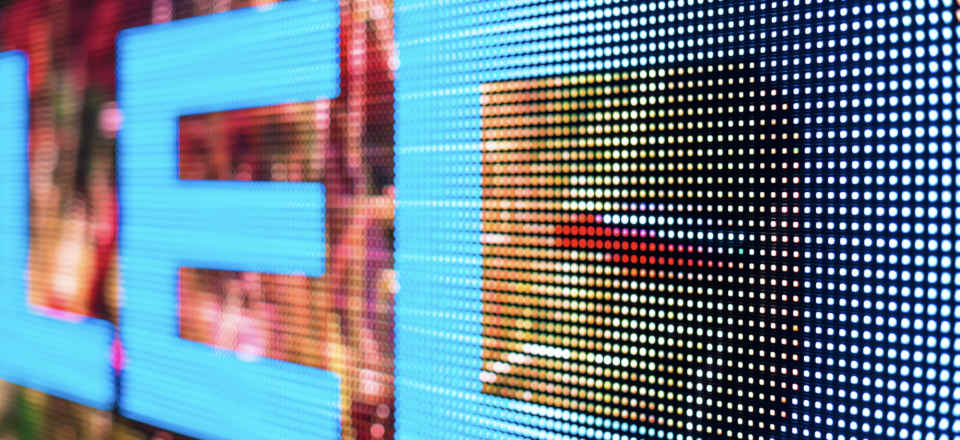Wie erscheint Ihre Stellenanzeige mit LED, OLED oder MicroLED Technologie?
Stellenanzeigen werden – wie schon der Begriff deutlich macht – angezeigt. Einfach so. Doch die dahinterliegende Technologie wird selten ausführlich erläutert. Das hat Anna Kucirkova jetzt geändert und erklärt Schritt für Schritt, was diese Technologie wirklich ausmacht.

Do you understand how LED, OLED, and MicroLED display technology work? Here’s what you need to know
By Anna Kucirkova
Full-color, vivid, ultra-thin visual displays. Portals, if you will, for entertainment, communication, and transfer of information – they’re all around us.
Laptop screens, desktop monitors, large-screen televisions, tablets, smartphones, e-readers, and more. They’re indispensable for both business and personal use. We spend hours looking at them.
This marvel of modern technology, now taken mostly for granted, incredibly just keeps getting better. Tiny light-emitting diodes (LEDs) are what makes it all possible.
What is display technology?
Displays are extremely complicated systems. It’s taken years for researchers, scientists, designers, and manufacturers to get the technology to the point it is today.
We’ve come a long way since the wavering TV images in the 1950s. Display technology has gone through massive revisions, but the displays that we enjoy today are merely the result of what began in those early years.
CRTs, for example, were the single most popular display technology used in television sets and computer monitors for over half a century. They were huge by today’s standards; it was not until the 2000s that LCDs began to gradually replace them. In the ’80s and ’90s, consumers could choose between rear-projection TVs, plasma television sets, and liquid crystal display (LCD) television sets.
Rear projection required lots of space. Plasma TV quality was good, but it quickly became outdated. (They’re not thin enough to be fashionable, they use more energy, and are susceptible to burn-in images.) LCD technology offered a new slim profile, making it ideal for wall mounting.
LCDs and LEDs took over. Both LED and LCD televisions are based on LCD technology. There used to be a difference between the two –
“Older LCD televisions used cold cathode fluorescent lamps to provide backlighting, whereas LED-backlit LCD televisions used an array of smaller, more efficient light-emitting diodes (LEDs) to illuminate the screen… all LCD TVs now use LED lights and are considered LED TVs.”
What does LED stand for?
LED stands for Light Emitting Diode. These electronic components were first used in calculators and other devices. They were expensive at first.
As LED technologies improved, they became less expensive, and more importantly, more efficient and durable. LEDs now cover the spectrum of visible, infrared and ultraviolet light. Since they produce light with less electricity, the hardware needed is different than the older incandescent lighting.
What is an LED Display?

Techopedia.com explains that an LED Display (light-emitting diode display) is a technology that uses a panel of LEDs as the light source for a screen to interface between a user and a system.
The biggest advantage of the LED display is its efficient and low-energy consumption, which is especially needed for handhelds and chargeable devices such as mobile phones and tablets.
What are the uses of LED display?
Once used primarily for indicator lamps or replacing small incandescent bulbs, they’re now suitable for all kinds of electronics, outdoor and room lighting, traffic signals, camera flashes, auto headlights, medical equipment and more. Their low energy consumption, small size, low weight, and long lifespan have made them a top choice for energy conservation.
How does LED technology work?
LEDs are tiny light bulbs that fit into an electrical circuit. They don’t have a filament (like incandescent bulbs) that will burn out, and they don’t get hot. LEDs are brilliant and have greater light intensity.
An LED display is made up of LED panels, each of which consists of a number of these Light Emitting Diodes. The diodes are lighted by the movement of electrons in a semiconductor material. LEDs are constructed to release a large number of photons outward, housed in a plastic bulb to focus the light to project in a particular direction.
Unlike older technologies, a much higher percentage of electrical power goes directly to generating light, which greatly reduces the demand for electricity.
What are the components of an LED display?
Visualled.com provides an excellent description of what makes up an LED display.
LED screens are modular devices with several components:
- Cabinets: The fundamental modular piece of the screen. Most giant LED screens are usually divided into a series of cabinets, which form the entire screen when joined together. LED cabinets make screen manufacturing and transport easier.
- Structural chassis: it is the frame that houses the other components of the cabinet. It can be manufactured in different materials according to the technical requirements of the installation. LED boards or modules: electronic modules comprised of an electronic board with LEDs and an outer plastic or metal carcass.
- Power sources: The piece that transforms and regulates the voltage of the electrical network to power the other electronic components.
- Data card: receives the image data that each cabinet will issue and distributes them to all the cabinet’s modules.
- Data circuit: a set of wiring used to connect the data cards with LED modules and to connect cabinets with each other.
- Power circuit: a set of wiring used to connect the power supplies to the other electronic components of the cabinet and to interconnect all the cabinets with the electrical network.
What is OLED?

An organic light-emitting diode (OLED) is a light-emitting diode like LEDs, however, the emissive electroluminescent layer is a film of organic compound that emits light in response to an electric current. This organic layer is situated between two electrodes; typically, at least one of these electrodes is transparent. OLEDs are used to create digital displays in devices such as television screens, computer monitors, portable systems such as smartphones, handheld game consoles, and PDAs.
What’s the main difference between LED and OLED?
When plasma TVs lost favor, LED/LCD became the dominant TV display technology. But the new competitor is OLED. OLED television display technology is fundamentally different from LED/LCD TVs.
Each pixel in an OLED display provides its own illumination, where all of the pixels in an LCD television are illuminated by an LED backlight. OLED displays work without a backlight, so they can be thinner and lighter than an LCD.
The organic materials used to create the semiconductors in OLEDs are flexible. Bendable lights and displays are possible now. As one researcher pointed out, you may be able one day soon to roll up your TV and take it with you.
Picture quality tends to be better in OLEDs but since advancements are still continuing to be made in LCDs, we may see the two competing for a long time.
Currently, OLED TVs are more expensive than LCD models due to the higher-priced electroluminescent materials or phosphors they use. They may be pricey for a while, but since OLEDs don’t need the backlighting LCDs need, they also consume less power than LCDs. OLEDs currently experience screen burn-in more than LCDs, too, but that could change as the technology improves.
Who plans to launch 3 OLED-based devices soon?
It probably won’t surprise you to learn that Apple hopes to launch 3 OLED-based iPhones in 2020. “Apple reportedly plans to launch three OLED-based new iPhone devices in 2020 available in 5.42-, 6.06- and 6.67-inch sizes, respectively, according to sources from Taiwan’s handset component supply chain.”
What is microLED?

MicroLED, also known as mLED, is yet another emerging flat-panel display technology. It’s even more advanced, with a display consisting of microscopic LEDs which form the pixel elements.
It’s hard to imagine, but in comparison to LCD technology, microLED has even better contrast, response time, and energy efficiency.
MicroLEDs are primarily directed to low-energy small devices such as Apple watches and smartphones. Just like the OLEDs, microLEDs have reduced energy requirements compared to conventional LCD. According to Geekboots.com, experts estimate that microLED may use just half the energy of OLEDs to produce comparable illumination. Other estimates say the energy savings will be even greater.
Will microLED televisions be coming soon?
Two years in a row at CES, the world’s largest technology show, Samsung showcased their gigantic „The Wall“ display, featuring microLED technology.
“At 219 inches, the newest version of The Wall — as Samsung calls it — is absolutely gigantic. But even better, the company now has one that’s smaller. A new 75-inch MicroLED TV is still just a prototype with no word of when it will go on sale, but the first consumer version, called The Wall Luxury, goes on sale in July (2019). No word on how much it will cost, but „a lot“ is a safe assumption.”
What is 4K Ultra HD technology?
Shortly before the beginning of the new millenium, high definition televisions along with high definition broadcasting were introduced in the U.S. This quickly became the standard type of broadcasting with hundreds of HD channels available.
HD TV provided about five times as many pixels as standard television. The increased resolution granted a clearer, more precise picture than was available up before that time.
And now there’s an even better experience – 4K Ultra High-Definition (4K Ultra HD) television. Some feel that the picture quality is like the 4K digital cinema experience in movie theaters. 4K resolution is four times the resolution of today’s leading HD televisions and reproduces colors more dramatically than HDTVs. 4K Ultra HD has been dubbed the “next generation” of display technology for the home.
How do you compare display resolutions?
A simple key to remember is this: The higher the resolution number, the better quality picture you’ll have. The experts at Crutchfield explain:
Numbers like 1080p and 4K refer to a TV’s screen resolution — the more pixels a screen has the more picture detail it can show.
A 1080p TV screen is 1920 pixels across by 1080 pixels down, the total number of pixels is 2,073,600.
Ultra HD is roughly 4000 pixels across. To be precise, a 4K TV screen is 3840 pixels across by 2160 down, for an impressive 8,294,400 total pixels — 4 times the resolution of 1080p.
The pixels of a 4K Ultra HD TV are much smaller than those of a 1080p HDTV, letting you see much finer picture detail.
Choosing between an HD or Ultra HD model was more difficult a couple of years ago, when 4K TVs cost way more than comparable HDTVs, and there wasn’t much 4K content to watch. Now that name-brand 4K models start under $400, and Netflix® and Amazon stream most of their original series in 4K, there’s not much reason to consider an HD model, at least for your main TV.
There is no perfect choice that fits everyone’s needs. Figure out what you can afford, and which features are the most important to you. It’s a sure bet you’re going to enjoy any of the outstanding display options being offered today.





